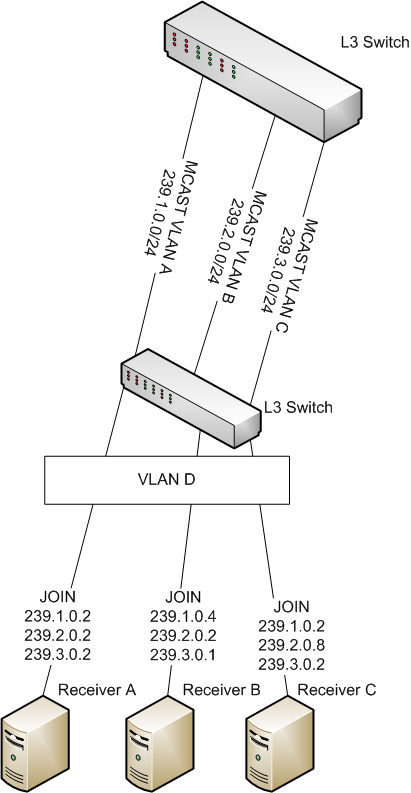- Cisco Community
- Technology and Support
- Service Providers
- Other Service Provider Subjects
- IP Multicast Layer 2 Aggregation
- Subscribe to RSS Feed
- Mark Topic as New
- Mark Topic as Read
- Float this Topic for Current User
- Bookmark
- Subscribe
- Mute
- Printer Friendly Page
IP Multicast Layer 2 Aggregation
- Mark as New
- Bookmark
- Subscribe
- Mute
- Subscribe to RSS Feed
- Permalink
- Report Inappropriate Content
08-18-2014 12:52 PM
Please see the below diagram. I have a scenario where we currently receive three multicast sources on dedicated VLANs. As of today we do not do any pruning or snooping on this VLAN it is broadcast based and we would like to keep it that way as some receivers are mandated to not be IGMP-dependent.
HOWEVER, there is an exception. We have a network of receivers that need to have the granularity to request multicast group membership from multiple source VLANs and have non-interested traffic pruned from the receivers. This is a simple setup in a scenario where you have a single VLAN for the senders as I would just turn up a snooper/querier setup and let the local L3 switch handle the joins/leaves. Unfortunately though we have this need to allow multiple source VLANs to be candidates for sending to any downstream receiver. What I don't want to do is change the nature of the upstream multicast streams coming in to the switch. If that were the case then we could go to a routed multicast environment and not have to worry about VLAN segmentation issues.
What is the best practice/recommended config to allow a setup like this to work? I'm also concerned with the possibility of flooding multicast between VLAN A,B and C accidentally by combining the VLANs.

- Labels:
-
SP Video
- Mark as New
- Bookmark
- Subscribe
- Mute
- Subscribe to RSS Feed
- Permalink
- Report Inappropriate Content
08-22-2014 11:10 AM
I don't understand this question.
- Mark as New
- Bookmark
- Subscribe
- Mute
- Subscribe to RSS Feed
- Permalink
- Report Inappropriate Content
08-25-2014 11:00 AM
I need to be able to request streams from VLAN A, B, C on receivers on VLAN D. VLAN A, B, C are broadcast-based (no PIM or IGMP snooping) but I need the receivers on VLAN D to be pruned based on the stream that is being requested.
- Mark as New
- Bookmark
- Subscribe
- Mute
- Subscribe to RSS Feed
- Permalink
- Report Inappropriate Content
08-26-2014 02:44 AM
Have SVIs for VLAN A,B,C,D on a bottom switch (they'll pickup streams) & enable IGMP snooping only for VLAN D.
- Mark as New
- Bookmark
- Subscribe
- Mute
- Subscribe to RSS Feed
- Permalink
- Report Inappropriate Content
08-26-2014 03:07 AM
- Mark as New
- Bookmark
- Subscribe
- Mute
- Subscribe to RSS Feed
- Permalink
- Report Inappropriate Content
08-26-2014 04:17 AM
Yes, PIM must be enable to route it. I don't have experience with this kind of design, but it should work unless there is some limitation.
Discover and save your favorite ideas. Come back to expert answers, step-by-step guides, recent topics, and more.
New here? Get started with these tips. How to use Community New member guide